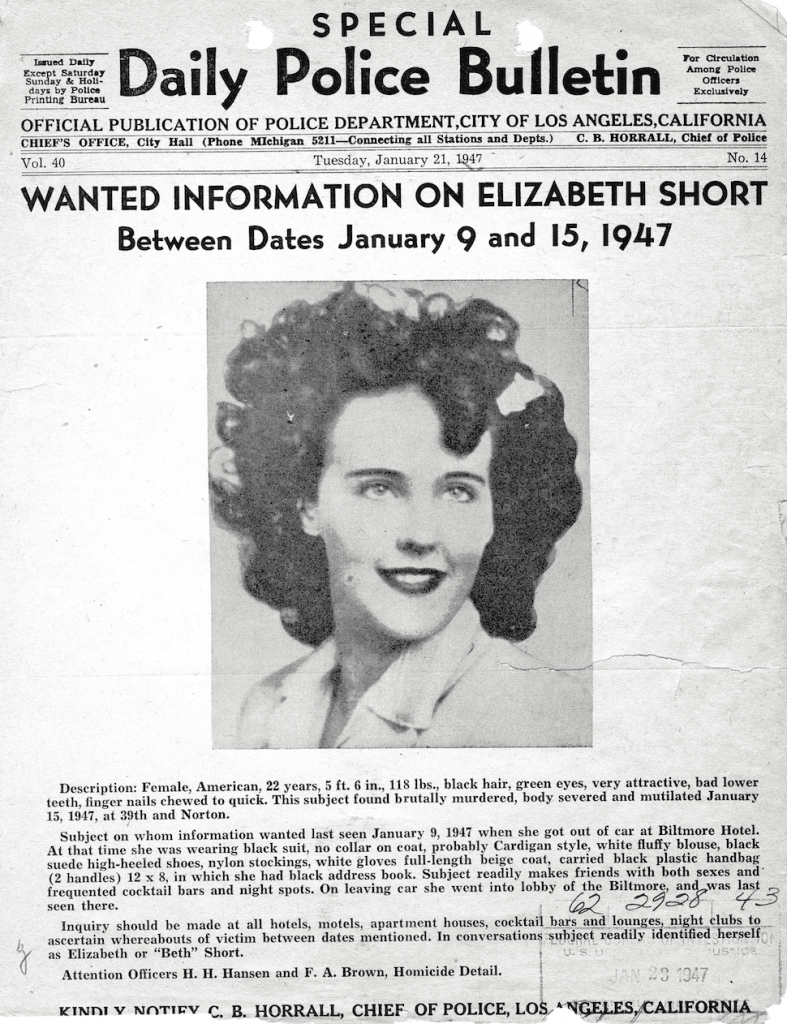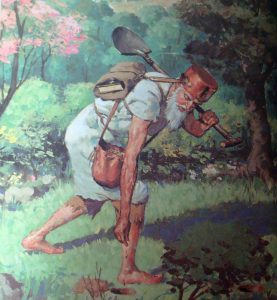Winner of the Fall 2019 StMU History Media Award for
Best Article in the Category of “Crime”
Elizabeth Short, widely known as The Black Dahlia, was a young 22-year-old American woman who was raped, brutally murdered, dismembered, and thrown on a vacant lot in a Los Angeles suburb for everyone to see. Elizabeth’s murder took place in Los Angeles County on January 15, 1947. No one knows the exact events that led to Elizabeth Short’s last moments when she fought for her life. There was no murder confession, and there was a lack of evidence to lead investigators further. Sadly, Elizabeth Short and her family never saw justice for her brutal murder. To this day, the case of The Black Dahlia is still unsolved. A man named Steve Hodel believed that The Black Dahlia murder was in fact not unsolved. Steve Hodel, a former detective, believed he had solved one of Los Angeles’ most notorious murders—but the infamous, troubled, charismatic doctor that Steve Hodel accused for being Short’s murderer, happened to be his own father, George Hodel.1
Elizabeth Short aspired to be an actress, and her young life was full of drinking and partying. She was very attracted to men and the sexual connections that came with men. Short had a desire to attend nightspots and nightclubs. Going to these nightspots, she frequently drew attention to herself, and she was arrested on September 23, 1943 for underage drinking of alcohol. She was only nineteen.2 By this time, Elizabeth had achieved a reputation as an aspiring actress who would go to bed with anyone who could possibly offer her a part in a movie.3 But her lifestyle soon led her to have a horrible encounter with a horrible man.

January 15, 1947 was just like any other day in the Los Angeles area. It was especially cool and overcast, which set the mood for the horrific discovery later that morning. A woman walking with her young daughter caught a glimpse of white flesh through a clump of brown grass in a vacant lot just a few inches from the sidewalk.4 They stumbled across the horrific sight of Elizabeth Short’s naked body cut in half just above the hipbone, drained of blood and arranged as if on display, with her legs spread and arms raised at right angles above her head. In a gruesome addition, two knife gashes extended her mouth up towards her ears.5 Her body also had the letters “B D” carved deeply into one thigh, and these letters were believed to represent the initials of Elizabeth Short’s well-known nickname Black Dahlia.6 This name stuck with her because of her tendency to always wear black clothing that contrasted with her white complexion, as well as having a dahlia flower in her hair on most occasions.7

George Hodel seemed to be an extraordinary man. He was a phenomenal doctor with a very respected reputation. Due to the extensive dismembering and perfect cuts discovered on Elizabeth’s body, her murderer had to have been a doctor.8 A couple years after the Black Dahlia murder, in 1949, Dr. Hodel’s reputation was left in tatters when he was tried for incest with his daughter Tamar Hodel, Steve Hodel’s half-sister.9 This trial brought light to George Hodel’s name in the police department. Because everyone knew that he was a very talented doctor, Dr. Hodel was put at the top of the suspect list for Elizabeth Short’s murder. Due to police corruption at the time, Dr. Hodel’s possible guilt was not presented to the public.
Dr. Hodel ended up passing away on May 16, 1999 due to a heart attack.10 Upon his passing, his son Steve Hodel began an intensive investigation into his father’s past. Steve Hodel made the trip to his father’s home to gather his father’s assets. While looking through his father’s belongings, Steve came across a tiny, palm-sized wood-bound photo album, with twelve golden fleurs-de-lys imprinted on the front.11 Inside this photo album, Steve discovered a number of strange photos of many familiar women. One of the women looked very similar to the Black Dahlia, Elizabeth Short. There were two photos of this women. In one, the woman had paper dahlia flowers in her hair. In the other, the woman was nude with her eyes shut.12 After Steve realized that the women in his father’s old photo album was the Black Dahlia, he became determined to find answers, to possibly clear his father’s name in the eyes of the law. Shortly into his private investigation, Steve Hodel realized that the evidence he was uncovering led to his father’s obvious guilt, not his exoneration. Now he wanted only to do all he could to prove it.
When Steve Hodel started the investigation into his father’s connection to the murder of the Black Dahlia, he found a substantial amount of sufficient yet circumstantial evidence against him. He soon found out that his father and Elizabeth Short knew each other. They had met in 1944 and had begun a non-sexual relationship. George would provide Elizabeth with financial aid for food and rent whenever she needed it in return for showing love interest in George. Steve’s suspicions of his father’s guilt skyrocketed when he came to find out that Elizabeth and his father were together at a downtown hotel three days before Elizabeth’s body was found. During the course of Steve Hodel’s investigation, he recognized his father’s unique handwriting multiple times, especially on the original note mailed by the Black Dahlia Avenger to the LAPD and to the press. The note with his father’s handwriting read “Here it is; Turning in Wed; Jan. 29 10 A.M.; Had my fun at police; Black Dahlia Avenger.” This was the first note that the Black Dahlia Avenger made no attempt to distort or conceal his actual handwriting.13 Hand writing analysis has since confirmed these claims. Although this evidence is circumstantial, Steve Hodel was very passionate in proving his father’s guilt. Another piece of incriminating evidence was a white-faced military watch that Dr. Hodel was seen wearing in contemporary photographs. A similar watch was found in the vacant lot close to where Elizabeth’s body was found.14
A number of men and one woman confessed to the crime, but none of them were able to match the gory details of the slaying known only by the police.15 Elizabeth’s murder seemed to bring out the worst among the psychologically disturbed in the Los Angeles area. The police were overwhelmed with the number of people who confessed to the murder.16 Despite all of these possible killers, Steve Hodel still truly believes that George Hodel was the guilty one.

The former detective for the LAPD and George Hodel’s son, Steve Hodel, had concluded his investigation on his father’s guilt, and developed an accurate timeline and detailed insight into Elizabeth Short’s last moments. Steve Hodel believes that the torture began on January 14, 1947 around 3:00-4:00 PM. Around this time, George Hodel took Elizabeth Short to the Franklin House. He gagged her mouth, bound her hands and feet with rope, and then began a prolonged and systematic process in which Elizabeth was beaten and subjected to ritualistic and sadistic torture.17 The torture included, but was not limited to the infliction of minor cuts to her body. She was beaten and kicked about her entire body, and she was forced to eat her own or his fecal excrement. Large pieces of flesh were cut from Elizabeth’s body and inserted into her orifices. Her face and breasts were also cut to imitate two of Man Ray’s famous photographs.18 Following this unimaginable torture, George Hodel then proceeded to sexually assault the then-slain Elizabeth Short.19 Although Elizabeth Short’s murderer was never convicted, it is now widely believed that George Hodel is the guilty one. The case of the Black Dahlia is considered an unsolved murder to this day, which makes it the most horrific unsolved murder in American history.20 Steve Hodel did not start his investigation until after George Hodel passed away, and only then because he passed away. George Hodel got away with his crime for over forty years. And even if he had not passed away until later in his life, face it, he still probably wouldn’t have ever been held to pay for his crime.
- Grace Bradberry, “My father was the Black Dahlia killer,” The Times, April 24, 2003. ↵
- Steve Hodel, Black Dahlia Avenger: A Genius for Murder (New York: Arcade Pub., 2003), 18. ↵
- Spectacular Crimes of the 1940s, 2007, s.v. “The Black Dahlia Case.” ↵
- Steve Hodel, Black Dahlia Avenger: A Genius for Murder (New York: Arcade Pub., 2003), 10. ↵
- Grace Bradberry, “My father was the Black Dahlia killer,” The Times, April 24, 2003. ↵
- Women in World History: A Biographical Encyclopedia, 2002, s.v. “Short,Elizabeth(1925–1947),” by Anne Commire. ↵
- Women in World History: A Biographical Encyclopedia, 2002, s.v. “Short,Elizabeth(1925–1947),” by Anne Commire. ↵
- Grace Bradberry, “My father was the Black Dahlia killer,” The Times, April 24, 2003. ↵
- Grace Bradberry, “My father was the Black Dahlia killer,” The Times, April 24, 2003. ↵
- Steve Hodel, Black Dahlia Avenger: A Genius for Murder (New York: Arcade Pub., 2003), 22. ↵
- Steve Hodel, Black Dahlia Avenger: A Genius for Murder (New York: Arcade Pub., 2003), 36. ↵
- Grace Bradberry, “My father was the Black Dahlia killer,” The Times, April 24, 2003. ↵
- Steve Hodel, Black Dahlia Avenger: A Genius for Murder (New York: Arcade Pub., 2003), 273. ↵
- Steve Hodel, Black Dahlia Avenger: A Genius for Murder (New York: Arcade Pub., 2003), 445. ↵
- Women in World History: A Biographical Encyclopedia, 2002, s.v. “Short, Elizabeth (1925–1947),” by Anne Commire. ↵
- Spectacular Crimes of the 1940s, 2007, s.v. “The Black Dahlia Case.” ↵
- Steve Hodel, Black Dahlia Avenger: A Genius for Murder (New York: Arcade Pub., 2003), 434. ↵
- Steve Hodel, Black Dahlia Avenger: A Genius for Murder (New York: Arcade Pub., 2003), 445. ↵
- Steve Hodel, Black Dahlia Avenger: A Genius for Murder (New York: Arcade Pub., 2003), 434. ↵
- Women in World History: A Biographical Encyclopedia, 2002, s.v. “Short, Elizabeth(1925–1947),” by Anne Commire. ↵



115 comments
Mitchell Yocham
Personally I love reading about crime and murders because I like to see how far a person would go to commit or cover up a murder. Some people are just extremely sick and unfortunately some people pay the price and our taken out by them. I do think that what was done to the Black Dahilia was completely disgusting and horribly wrong and I wish that people didn’t have to suffer at the expense of other’s emotions.
Emmanuel Diaz
The Black Dahlia case has always been interesting to me. Though in reality it is very confusing and honestly very horrific as well. her body was left just in a horrific state and it is terrifying to see what a human being can do to another, or in this case the detectives father. I applaud the detective for continuing the search to bring justice and to bring the case to a close as it ha left many completely lost and confused. The story leaves me in complete shock and wonder.
Cynthia Perez
The way her murder was described in gruesome explicit detail makes the article very realistic as the story of Black Dahlia is being told. Imagining how sick it would be to stumble upon a human body in that manner, should induce a strong repulsion and ill feeling as it did a really great job at doing. It is a bit odd that the case went unsolved even when there was a suspect who went unquestioned however it it’s interesting to reflect on and wonder what really could’ve happened.
Elizabeth Maguire
Before reading this article, I had never heard of the story about Elizabeth Short. It seems crazy that her case has been left unresolved even though the suspected person for the murder was George Hodel. This article captures not only the horrifying and disturbing images of the murder of the Black Dahlia but also sadness and pure strength from the son, in basically finding out that the evidence was related towards his father must have been difficult to understand at that moment in time.
Kelsey Sanchez
I have never heard of the story about Elizabeth Short. It seems crazy that her case has been left unresolved even though the suspected person for the murder was George Hodel. It is sad to hear that she had lived a fun life and then simply had her life taken away by someone abusing her. What was really surprising to read was that men and women would confess to the police that they were guilty of what had happened. However, their story did not match with what the police had discovered. I wonder if men and women did it for something because it seems strange to have to go to the police and claim to be guilty of something that did not happen by them. I also was surprised by the way George’s son, Steve had discovered about his father having a relationship with Elizabeth short, which could prove that he was guilty, but unfortunately, he is not confirmed to be the one.
Kimberly Parker
This article was so captivating, it captured the horrifying and disturbing images of the murder of the Black Dahlia in great detail. It was so interesting that the leading detective that was on the case found his own father as the murderer, and that he continued to seek evidence to prove just that, even after his death. That left me so shocked. Now thinking about other things that I’ve read, I remember them always say that it’s always the ones we least expect to be the individuals we should fear the most, and for this article and story it fits just right.
Vania Gonzalez
This article is very interesting and very well written. The black dahlia is well known and a common phrase used today to describe someone and Elizabeth started that. It sounds like a crime of passion like if George was jealous which could have been true Elizabeth could have found someone else and began to stop showing attention that George craved and wanted so he killed her. I can’t imagine what it was like for Steve to find this evidence against his father and proving it in his eyes his father was guilty even if it was never declared solved.
John Estrada
The infamous black dahlia murder is the use of many discussions in criminology and forensics classes. It’s a famous case not only for its mystery but for its terrifying display. Everyone is familiar with the Dahlia smile. What I wasn’t familiar with was her backstory and the investigation present in the article. It was interesting to read of a man trying to clear his father’s name, only to do his best to prove him guilty, finding very convincing evidence. Even more interesting to read was the history of Dahlia, to learn of her acting background and her less than moral choices in life, leading to her unfortunate death.
Juan Arceo
I have heard about other cases like this with several other serial killers, but this article written about Elizabeth Short and Dr. Hodel tops the books. This article didn’t just capture the horrifying and disturbing images of the murder of the Black Dahlia but also sadness and pure strength from the son, in basically finding out that the evidence was related towards his father must have been difficult to understand at that moment in time.
Patricia Arechiga
I recall watching a YouTube video regarding the Black Dahlia and feeling nothing but disgust. Not only was the finding of her tortured body beyond gruesome, but the fact that another human being had the capability of committing such actions towards another individual. I found it pretty interesting how the leading detective on the case found his own father as the murderer and continued to seek evidence to prove just that, even after his death. It is always the ones we least expect to be the individuals we should fear the most.